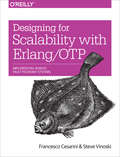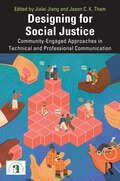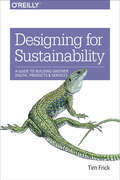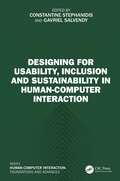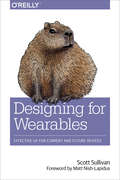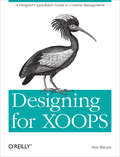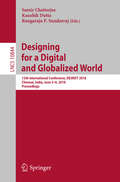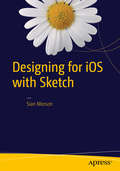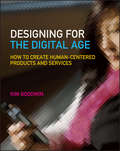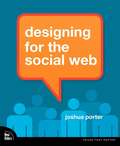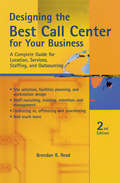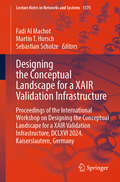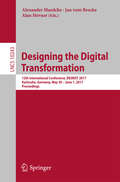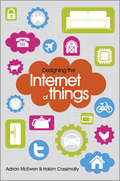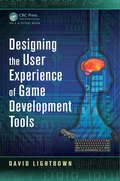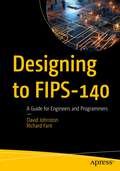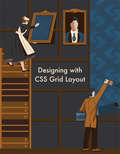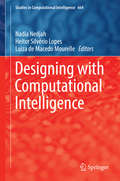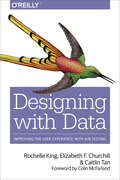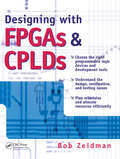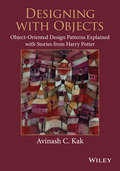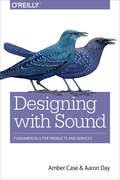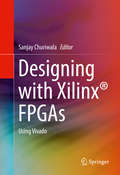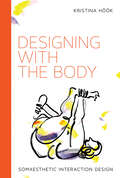- Table View
- List View
Designing for Scalability with Erlang/OTP: Implement Robust, Fault-Tolerant Systems
by Francesco Cesarini Steve VinoskiIf you need to build a scalable, fault tolerant system with requirements for high availability, discover why the Erlang/OTP platform stands out for the breadth, depth, and consistency of its features. This hands-on guide demonstrates how to use the Erlang programming language and its OTP framework of reusable libraries, tools, and design principles to develop complex commercial-grade systems that simply cannot fail.In the first part of the book, you’ll learn how to design and implement process behaviors and supervision trees with Erlang/OTP, and bundle them into standalone nodes. The second part addresses reliability, scalability, and high availability in your overall system design. If you’re familiar with Erlang, this book will help you understand the design choices and trade-offs necessary to keep your system running.Explore OTP’s building blocks: the Erlang language, tools and libraries collection, and its abstract principles and design rulesDive into the fundamentals of OTP reusable frameworks: the Erlang process structures OTP uses for behaviorsUnderstand how OTP behaviors support client-server structures, finite state machine patterns, event handling, and runtime/code integrationWrite your own behaviors and special processesUse OTP’s tools, techniques, and architectures to handle deployment, monitoring, and operations
Designing for Social Justice: Community-Engaged Approaches in Technical and Professional Communication (ATTW Series in Technical and Professional Communication)
by Jialei Jiang Tham, Jason C. K.Exploring the intersection of design research and community engagement, this book highlights the ways in which design and design theories can be used to address social justice issues and promote positive change in communities.Contributors illuminate the theoretical, ethical, and pedagogical dimensions of design-driven methods in community-engaged projects, exploring their potential to address critical social justice issues such as ethnic and racial justice, gender equality, disability justice, cultural diversity, equity, and environmental justice. Chapters examine various aspects of community-engaged practices, including the use of design theories to fuel social justice work in community partnerships, ethical issues surrounding the use of multimodal resources and new media technologies, and pedagogies for promoting social change. Addressing the opportunities and challenges of design and design methods in community engagement, this collection offers suggestions for promoting social justice through technical and professional communication activities and pedagogies.Investigating the design of community-engaged projects from a critical standpoint, this book will appeal to scholars and students in the fields of Technical and Professional Communication, Writing and Composition Studies, and Rhetoric. It will also be of interest to administrators, community partners, and professionals working in service-learning contexts.
Designing for Sustainability: A Guide to Building Greener Digital Products and Services
by Tim FrickPixels use electricity, and a lot of it. If the Internet were a country, it would be the sixth largest in terms of electricity use. That’s because today’s average web page has surpassed two megabytes in size, leading to slow load times, frustrated users, and a lot of wasted energy. With this practical guide, your web design team will learn how to apply sustainability principles for creating speedy, user-friendly, and energy-efficient digital products and services.Author Tim Frick introduces a web design framework that focuses on four key areas where these principles can make a difference: content strategy, performance optimization, design and user experience, and green hosting. You’ll discover how to provide users with a streamlined experience, while reducing the environmental impact of your products and services.Learn why 90% of the data that ever existed was created in the last yearUse sustainability principles to innovate, reduce waste, and function more efficientlyExplore green hosting, sustainable business practices, and lean/agile workflowsPut the right things in front of users at precisely the moment they need them—and nothing moreIncrease site search engine visibility, streamline user experience, and make streaming video more efficientUse Action Items to explore concepts outlined in each chapter
Designing for Usability, Inclusion and Sustainability in Human-Computer Interaction
by Gavriel Salvendy Constantine StephanidisAddressing the rising prevalence of interactive systems in our daily lives, this book focuses on the essential aspects of usability, user experience (UX), and inclusive design.This book Discusses both theoretical and practical aspects, approaches, and methods for the design process and the collaboration between HCI Design and Software Engineering. Expands to practical topics such as web and mobile design, aesthetics, information visu- alization, information architecture, and navigation design, along with relevant guidelines and standards. Tackles the issue of persuasive interfaces that has arisen as a crucial concern in the contemporary digitalized landscape. Emphasizes the importance of making computing systems inclusive and user-friendly for a diverse range of users, including children, older adults, and persons with disabilities. Highlights the significance of usability, underscoring its key role in enhancing the overall user experience of interactive products.This book has been written for individuals interested in Human-Computer Interaction research andapplications..
Designing for Wearables: Effective UX for Current and Future Devices
by Scott SullivanNow may be the perfect time to enter the wearables industry. With the range of products that have appeared in recent years, you can determine which ideas resonate with users and which don’t before leaping into the market. In this practical guide, author Scott Sullivan examines the current wearables ecosystem and then demonstrates the impact that service design in particular will have on these types of devices going forward.You’ll learn about the history and influence of activity trackers, smartwatches, wearable cameras, the controversial Google Glass experiment, and other devices that have come out of the recent Wild West period. This book also dives into many other aspects of wearables design, including tools for creating new products and methodologies for measuring their usefulness.You’ll explore:Emerging types of wearable technologiesHow to design services around wearable devicesKey concepts that govern service designPrototyping processes and tools such as Arduino and ProcessingThe importance of storytelling for introducing new wearablesHow wearables will change our relationship with computers
Designing for XOOPS: A Designer's Quickstart Guide to Content Management
by Sun RuoyuLearn how to customize websites with XOOPS, the open source CMS that helps non-developers build dynamic community websites, intranets, and other applications. This concise book shows you how to use XOOPS themes and modules to design everything from simple blogs to large database-driven CMS portals.Web designers and current XOOPS users will learn how to create a site theme with CSS and jQuery libraries, including techniques for making additional modules conform to the site's look and feel. Although XOOPS uses the PHP-based Smarty templating system, all you need is a bit of XHTML and CSS experience to get started.Learn the workflow for turning an idea into a full-featured websiteBecome familiar with XOOPS’ theme-building tools, and set up PHP and MySQL environmentsPort an existing XHTML template to XOOPSCreate themes with the 960 Grid System to save time and reduce codeUse jQuery-based UI libraries to achieve complex effectsBlend new modules into your theme with the template override functionGo beyond traditional block layouts to customize your homepage
Designing for a Digital and Globalized World: 13th International Conference, Desrist 2018, Chennai, India, June 3-6, 2018, Proceedings (Theoretical Computer Science and General Issues #10844)
by Samir Chatterjee Kaushik Dutta Rangaraja P. SundarrajThis book constitutes the proceedings of the 13th International Conference on Design Science Research in Information Systems and Technology, DESRIST 2018, held in June 2018 in Chennai, India. The 24 full papers presented in this volume were carefully reviewed and selected from 96 papers. The contributions are organized in topical sections named: HCI and Design, Design Foundations, Design Foundations, Design in Healthcare, Advances in Data Science and Analytics, ICT for Development, Designing Cybersecurity, and Design Applications.
Designing for iOS with Sketch
by Sian MorsonDesigning for iOS with Sketch takes you through the process of designing your iOS app using Bohemian Code's Sketch. Sketch is a powerful new design program that is quickly replacing Adobe PhotoShop for many designers designing for mobile apps and the mobile web. This book will introduce you to the program and then take you through the steps of designing your very own app. It includes examples and shortcuts as well as a helpful list of plugins and 3rd party resources that will greatly improve your workflow. What you'll learn What sets Sketch apart from PhotoShop and Illustrator Use Sketch to design a simple iOS app Learn helpful shortcuts to speed up your workflow Get a helpful list of resources from around the web Includes a list of plugins to extend Sketch and make designing more fun Who this book is for Beginning to intermediate iOS app designers who are looking for an alternative to PhotoShop. Table of Contents Chapter 1: Why Sketch? Chapter 2: The Sketch Interface Chapter 3: Shapes and Styles Chapter 4: Symbols Chapter 5: Text and Fonts Chapter 6: Optimizing Your Workflow Chapter 7: Creating a Simple App Chapter 8: Creating an Icon Chapter 9: Exporting Assets for Development Chapter 10: Sketch Resources and Plugins
Designing for the Digital Age: How to Create Human-Centered Products and Services
by Kim GoodwinWhether you're designing consumer electronics, medical devices, enterprise Web apps, or new ways to check out at the supermarket, today's digitally-enabled products and services provide both great opportunities to deliver compelling user experiences and great risks of driving your customers crazy with complicated, confusing technology. Designing successful products and services in the digital age requires a multi-disciplinary team with expertise in interaction design, visual design, industrial design, and other disciplines. It also takes the ability to come up with the big ideas that make a desirable product or service, as well as the skill and perseverance to execute on the thousand small ideas that get your design into the hands of users. It requires expertise in project management, user research, and consensus-building. This comprehensive, full-color volume addresses all of these and more with detailed how-to information, real-life examples, and exercises. Topics include assembling a design team, planning and conducting user research, analyzing your data and turning it into personas, using scenarios to drive requirements definition and design, collaborating in design meetings, evaluating and iterating your design, and documenting finished design in a way that works for engineers and stakeholders alike.
Designing for the Social Web
by Joshua PorterWith tons of examples from real-world interfaces and a touch of the underlying social psychology theory, Joshua Porter shows you how to design your next great social web application.
Designing for the iPad
by Chris StevensGet in the game of developing successful apps for the iPadDesigning for the iPad presents unique challenges for developers and requires an entirely different mindset of elements to consider when creating apps. Written by a highly successful iPad software developer, this book teaches you how to think about the creation process differently when designing iPad apps and escorts you through the process of building applications that have the best chance for success. You'll learn how to take advantage of the iPad's exciting new features and tackle an array of new design challenges so that you can make your app look spectacular, work intuitively, and sell, sell, sell!Bestselling iPad app developer Chris Stevens shares insight and tips for creating a unique and sellable iPad appWalks you through sketching out an app, refining ideas, prototyping designs, organizing a collaborative project, and moreHighlights new code frameworks and discusses interface design choicesOffers insider advice on using the latest coding options to make your app a surefire successDetails iPad design philosophies, the difference between industrial and retail apps, and ways to design for multiple screen orientationsDesigning for the iPad escorts you through the steps of developing apps for the iPad, from pencil sketch all the way through to the iPad App Store.
Designing the Best Call Center for Your Business
by Brendan ReadDesigning the Best Call Center for Your Business examines all key aspects of opening and expanding a live agent call center, with in-depth coverage on facilities and workstation design; site selection, including communications and power backups; f
Designing the Conceptual Landscape for a XAIR Validation Infrastructure: Proceedings of the International Workshop on Designing the Conceptual Landscape for a XAIR Validation Infrastructure, DCLXVI 2024, Kaiserslautern, Germany (Lecture Notes in Networks and Systems #1375)
by Fadi Al Machot Martin T. Horsch Sebastian ScholzeThis book focuses on explainable-AI-ready (XAIR) data and models, offering a comprehensive perspective on the foundations needed for transparency, interpretability, and trust in AI systems. It introduces novel strategies for metadata structuring, conceptual analysis, and validation frameworks, addressing critical challenges in regulation, ethics, and responsible machine learning.Furthermore, it highlights the importance of standardized documentation and conceptual clarity in AI validation, ensuring that systems remain transparent and accountable.Aimed at researchers, industry professionals, and policymakers, this resource provides insights into AI governance and reliability. By integrating perspectives from applied ontology, epistemology, and AI assessment, it establishes a structured framework for developing robust, trustworthy, and explainable AI technologies.
Designing the Digital Transformation: 12th International Conference, DESRIST 2017, Karlsruhe, Germany, May 30 – June 1, 2017, Proceedings (Lecture Notes in Computer Science #10243)
by Alexander Maedche, Jan vom Brocke and Alan HevnerThis book constitutes the proceedings of the 12th International Conference on Design Science Research in Information Systems and Technology, DESRIST 2017, held in May/June 2017 in Karlsruhe, Germany. The 25 full and 11 short papers presented in this volume were carefully reviewed and selected from 66 full and 19 short papers. The contributions are organized in topical sections named: DSR in business process management; DSR in human computer interaction; DSR in data science and business analytics; DSR in service science; methodological contributions; domain-specific DSR applications; emerging themes and new ideas; and products and prototypes.
Designing the Internet of Things
by Adrian Mcewen Hakim CassimallyTake your idea from concept to production with this unique guideWhether it's called physical computing, ubiquitous computing, or the Internet of Things, it's a hot topic in technology: how to channel your inner Steve Jobs and successfully combine hardware, embedded software, web services, electronics, and cool design to create cutting-edge devices that are fun, interactive, and practical. If you'd like to create the next must-have product, this unique book is the perfect place to start.Both a creative and practical primer, it explores the platforms you can use to develop hardware or software, discusses design concepts that will make your products eye-catching and appealing, and shows you ways to scale up from a single prototype to mass production.Helps software engineers, web designers, product designers, and electronics engineers start designing products using the Internet-of-Things approach Explains how to combine sensors, servos, robotics, Arduino chips, and more with various networks or the Internet, to create interactive, cutting-edge devices Provides an overview of the necessary steps to take your idea from concept through productionIf you'd like to design for the future, Designing the Internet of Things is a great place to start.
Designing the User Experience of Game Development Tools
by David LightbownMost tools developers want to improve the user experience but are not given the time, lack the techniques, or don't know where to begin.Designing the User Experience of Game Development Tools addresses these issues to empower tools developers to make positive steps toward improving the user experience of their tools.The book explains how to im
Designing to FIPS-140: A Guide for Engineers and Programmers
by David Johnston Richard FantThis book provides detailed and practical information for practitioners to understand why they should choose certification. It covers the pros and cons, and shows how to design to comply with the specifications (FIPS-140, SP800 documents, and related international specs such as AIS31, GM/T-0005-2021, etc.). It also covers how to perform compliance testing. By the end of the book, you will know how to interact with accredited certification labs and with related industry forums (CMUF, ICMC). In short, the book covers everything you need to know to make sound designs.There is a process for FIPS-140 (Federal Information Processing Standard) certification for cryptographic products sold to the US government. And there are parallel certifications in other countries, resulting in a non-trivial and complex process. A large market of companies has grown to help companies navigate the FIPS-140 certification process. And there are accredited certification labs you must contract toget the certification.Although this was once a fairly niche topic, it is no longer so. Other industries—banking, military, healthcare, air travel, and more—have adopted FIPS certification for cryptographic products. The demand for these services has grown exponentially. Still, the available skills pool has not grown. Many people are working on products with zero usable information on what to do to meet these standards and achieve certification or even understand if such certification applies to their products. What You Will Learn What is FIPS-140? What is the SP800 standard?What is certification? What does it look like? What is it suitable for?What is NIST? What does it do?What do accredited certification labs do?What do certification consultants do?Where and when is certification required?What do FIPS-140 modules look like?What are the sub-components of FIPS-140 modules (RNGs, PUFs, crypto functions)? How does certification work for them?What are the physical primitives (RNGs, PUFs, key stores) and how do you handle the additional complexity of certifying them under FIPS?What are the compliance algorithms (AES, SP800-90 algos, SHA, ECDSA, key agreement, etc.)?How do you design for certification (BIST, startup tests, secure boundaries, test access, zeroization, etc.)?How do you get CAVP certificates (cert houses, ACVTs)?How do you get CMVP certifications (cert houses, required documents, design information, security policy, etc.)? Who This Book Is For Hardware and software engineers or managers of engineering programs that include any form of cryptographic functionality, including silicon vendors, library vendors, OS vendors, and system integrators
Designing with CSS Grid Layout
by Nitish Kumar Ahmad Ajmi Adrian RoworthLayout in CSS has always been a tricky task: hacking solutions using positioning, floats, and the one-dimensional flexbox has never been very satisfactory. Fortunately, there is a new tool to add to our arsenal: CSS Grid Layout. It is an incredibly powerful layout system that allows us to design pages using a two-dimensional grid - offering the kind of fine-grained layout control that print designers take for granted! Grid Layout has been in development for a while, but has recently been made a W3C candidate recommendation and has been added to most of the major browsers, so is ready for prime time. This short selection of tutorials, hand-picked from SitePoint's HTML & CSS channel, will get you up and running with Grid Layout and using it on your own sites in no time. This collection includes: An Introduction to the CSS Grid Layout Module by Ahmad AjmiSeven Ways You Can Place Elements Using CSS Grid Layout by Nitish KumarHow to Order and Align Items in Grid Layout by Nitish KumarA Step by Step Guide to the Auto- Placement Algorithm in CSS Grid by Nitish KumarHow I Built a Pure CSS Crossword Puzzle by Adrian Roworth This book is suitable for front end developers and web designers with some CSS experience.
Designing with Computational Intelligence
by Nadia Nedjah Heitor Silvério Lopes Luiza de Macedo MourelleThis book discusses a number of real-world applications of computational intelligence approaches. Using various examples, it demonstrates that computational intelligence has become a consolidated methodology for automatically creating new competitive solutions to complex real-world problems. It also presents a concise and efficient synthesis of different systems using computationally intelligent techniques.
Designing with Data: Improving the User Experience with A/B Testing
by Caitlin Tan Elizabeth F Churchill Rochelle KingOn the surface, design practices and data science may not seem like obvious partners. But these disciplines actually work toward the same goal, helping designers and product managers understand users so they can craft elegant digital experiences. While data can enhance design, design can bring deeper meaning to data.This practical guide shows you how to conduct data-driven A/B testing for making design decisions on everything from small tweaks to large-scale UX concepts. Complete with real-world examples, this book shows you how to make data-driven design part of your product design workflow.Understand the relationship between data, business, and designGet a firm grounding in data, data types, and components of A/B testingUse an experimentation framework to define opportunities, formulate hypotheses, and test different optionsCreate hypotheses that connect to key metrics and business goalsDesign proposed solutions for hypotheses that are most promisingInterpret the results of an A/B test and determine your next move
Designing with FPGAs and CPLDs
by Bob Zeidman* Choose the right programmable logic devices and development tools * Understand the design, verification, and testing issues * Plan schedules and allocate resources efficiently Choose the right programmable logic devices with this guide to the technolog
Designing with Objects
by Avinash C. Kak* All code examples in the book are available for download on a companion site with resources for readers and instructors* A refreshing alternative to the rather abstract and dry explanations of the object-oriented design patterns in much of the existing literature on the subject* In 24 chapters, Designing with Objects explains well-known design patterns by relating them to stories from the Harry Potter series
Designing with Sound: Fundamentals for Products and Services
by Amber Case Aaron DaySound can profoundly impact how people interact with your product. Well-designed sounds can be exceptionally effective in conveying subtle distinctions, emotion, urgency, and information without adding visual clutter. In this practical guide, Amber Case and Aaron Day explain why sound design is critical to the success of products, environments, and experiences.Just as visual designers have a set of benchmarks and a design language to guide their work, this book provides a toolkit for the auditory experience, improving collaboration for a wide variety of stakeholders, from product developers to composers, user experience designers to architects. You’ll learn a complete process for designing, prototyping, and testing sound.In two parts, this guide includes:Past, present, and upcoming advances in sound designPrinciples for designing quieter productsGuidelines for intelligently adding and removing sound in interactionsWhen to use voice interfaces, how to consider personalities, and how to build a knowledge map of queriesWorking with brands to create unique and effective audio logos that will speak to your customersAdding information using sonification and generative audio
Designing with Xilinx® FPGAs
by Sanjay ChuriwalaThis book helps readers to implement their designs on Xilinx#65533; FPGAs. The authors demonstrate how to get the greatest impact from using the Vivado#65533; Design Suite, which delivers a SoC-strength, IP-centric and system-centric, next generation development environment that has been built from the ground up to address the productivity bottlenecks in system-level integration and implementation. This book is a hands-on guide for both users who are new to FPGA designs, as well as those currently using the legacy Xilinx tool set (ISE) but are now moving to Vivado. Throughout the presentation, the authors focus on key concepts, major mechanisms for design entry, and methods to realize the most efficient implementation of the target design, with the least number of iterations.
Designing with the Body: Somaesthetic Interaction Design (Design Thinking, Design Theory)
by Kristina HookInteraction design that entails a qualitative shift from a symbolic, language-oriented stance to an experiential stance that encompasses the entire design and use cycle. With the rise of ubiquitous technology, data-driven design, and the Internet of Things, our interactions and interfaces with technology are about to change dramatically, incorporating such emerging technologies as shape-changing interfaces, wearables, and movement-tracking apps. A successful interactive tool will allow the user to engage in a smooth, embodied, interaction, creating an intimate correspondence between users' actions and system response. And yet, as Kristina Höök points out, current design methods emphasize symbolic, language-oriented, and predominantly visual interactions. In Designing with the Body, Höök proposes a qualitative shift in interaction design to an experiential, felt, aesthetic stance that encompasses the entire design and use cycle. Höök calls this new approach soma design; it is a process that reincorporates body and movement into a design regime that has long privileged language and logic. Soma design offers an alternative to the aggressive, rapid design processes that dominate commercial interaction design; it allows (and requires) a slow, thoughtful process that takes into account fundamental human values. She argues that this new approach will yield better products and create healthier, more sustainable companies. Höök outlines the theory underlying soma design and describes motivations, methods, and tools. She offers examples of soma design “encounters” and an account of her own design process. She concludes with “A Soma Design Manifesto,” which challenges interaction designers to “restart” their field—to focus on bodies and perception rather than reasoning and intellect.
